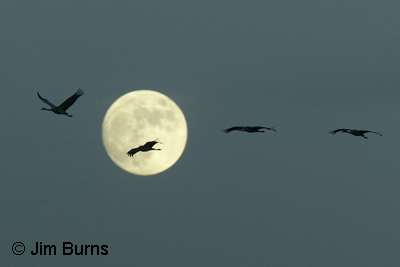
Sooner or later all serious birders must make the autumn pilgrimage to "The Bosque," Bosque Del Apache National Wildlife Refuge in New Mexico. This isn't about becoming a better birder. This is about renewing your vows, rewinding the chronicle of why you began, and untying the knots of stress inherent in big city life. If the howl of coyotes or the honking of geese stir your soul, a visit to the Bosque will feel like returning home to a place you’ve never really known.
Bosque Del Apache, “Woods of the Apache,” is a 57,000 acre refuge stretching nine miles along the Rio Grande River south of Socorro near the hamlet of San Antonio. The habitat is high desert plains cut by a riparian ribbon of cottonwood and willow. The Bosque exists to provide wintering habitat for the sandhill crane and the snow goose, species that are individually eye-catching but spectacularly breath-taking when seen, and heard, in flight in flocks.
The refuge’s main attraction is the 15 mile auto tour which winds through marshland and fields planted with alfalfa and corn to attract and hold the cranes and geese through the winter season. Though the tour road is only a few miles from the I-25 corridor, a drive through the refuge at sunrise or sunset, especially on a weekday, transports the human visitor back to sights and sounds from a time when our species was the exception and huge flocks of prehistoric birds were the rule.
There are deer and elk on the refuge, coyotes and eagles stalking the flocks, wild turkey, roadrunners, pheasants, and mountain bluebirds. Do not fail, at least one morning, to be at the Flight Deck observation platform before sunrise to watch the indescribable and cacophonous “blast-off” as thousands of cranes and geese take to the sky simultaneously across the golden light of the coming sun. Do not fail, at least one evening, to be at the “cranepools” along Highway 1 to watch the cranes drop through an orange-to-mauve-to-purple New Mexico sunset as they return to the safety of the water after a day of foraging in the corn.
Sandhills are awe-inspiring creatures, 4 feet tall with a wingspan of 6 1/2 feet. At peak season there are 15,000 of them on the refuge. Go now, as the cottonwood leaves turn to gold. Go now, before the weather turns too cold. Watch the skeins of these relicts from a simpler place and time undulate across the backdrop of the distant Chupadera Mountains, their hoarse bugling resonant with the winds of an ancient world. Go now and renew your soul.
IF YOU GO
Bosque Del Apache is located just east of Interstate 25 between Albuquerque and Las Cruces, 19 miles south of Socorro. The refuge is open from one hour before sunrise to one hour after sunset. There is a $3 entrance fee and a Visitor Center with restrooms. Driving time from Phoenix is approximately 6 hours.
WHERE TO STAY
There are 9 motels in Socorro and 3 bed & breakfasts in San Antonio. Camping is not allowed on the refuge.
WHAT TO WEAR
This is high desert, 4500 feet at the river. Fall temperatures before sunrise can be below freezing, but into the fifties and sixties by mid-afternoon. Wind chill is always a factor, and high winds are possible. Dress accordingly, dress in layers.
WHAT TO BRING
Binoculars, lunch, and water are essential. A spotting scope will greatly enhance the experience because this is a large refuge with open spaces and long views out over fields and marshes.
OTHER ATTRACTIONS
The Festival Of Cranes takes place at the refuge November 14 through 19 with
guided field trips and interpretive programs. There are three wilderness areas on the refuge and several hiking trails. Along the auto tour there are 7 observation platforms and a boardwalk.